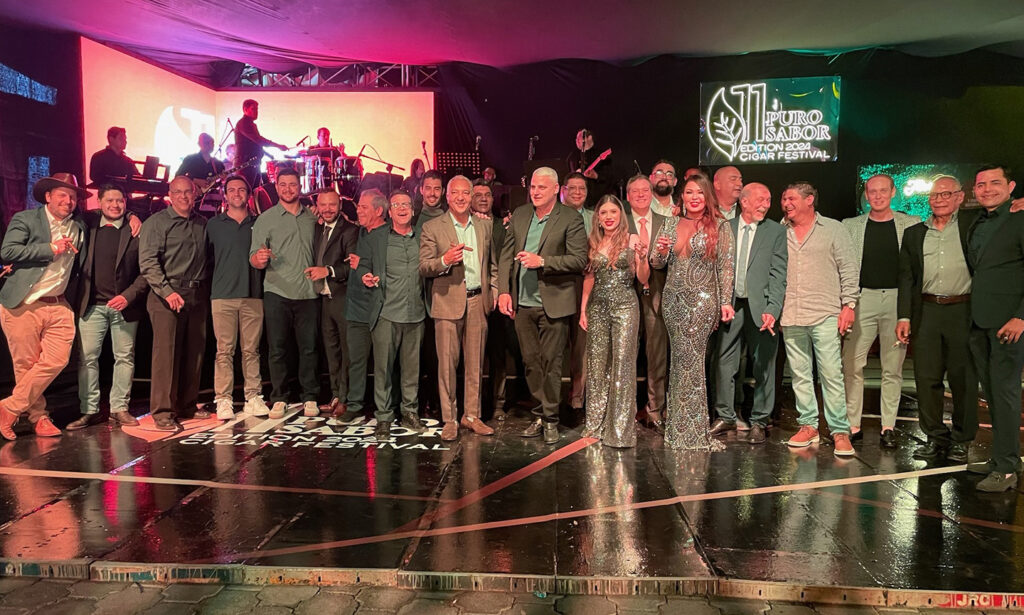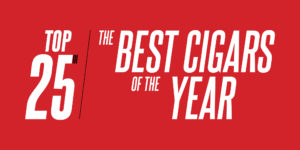The annual festival celebrating the Nicaraguan tobacco and cigar industry celebrated its 11th year with five days packed with events that guided guests through the heart of the country’s award-winning tobacco farms and cigar factories. The sold-out event drew a diverse audience representing 22 countries, all there to see first-hand how some of the best cigars in the world are made. Follow along as our team takes you along every twist and turn of this can’t-miss event. Next year’s Puro Sabor is slated for January 20-25th.
Day 1
And so it begins
The Puro Sabor festival kicked off with lunch at AJ Fernandez’s San Ramón farm in Estelí. The festival’s first “cigar moment” was with the AJ Fernandez Dias de Gloria while guests enjoyed food and cocktails amidst a backdrop of lush tobacco growing in the surrounding fields.
The Welcome Dinner was held at La Gran Fábrica Drew Estate, where they unveiled a new mural featuring the Deadwood Tobacco ladies. Flor de Caña 18 was poured from the barrel all night. The cigar moment was presented by Pedro Gomez and featured the Liga Privada Selección de Mercado. Guests enjoyed rock and blues from a live band while DE’s Henry Pineda poured Blackened Whiskey and handed out Blackened M81 cigars to finish out the night.
Day 2
A lesson in tobacco genetics, an onslaught of cigars
On day two, all participants were driven to Condega to visit Oliva’s Hacienda d’ Ernesto. It’s an understatement to call it simply a finca or farm, it’s more accurate to call it a tobacco farming and genetics complex. The groups split into two, with one group planting tobacco seedlings in the field and the other, the one we were on, receiving a crash course in tobacco varieties from Ernesto Milanes and tobacco genetics from Vivaldo Garcia. Ernesto is at the head of Oliva’s tobacco farming operations, and although the operation is called Hacienda d’ Ernesto, it isn’t named after him. Oliva’s owner Fred Vandermarliere’s young son is coincidentally named Ernesto as well, the hacienda is named after him.
Vivaldo Garcia wowed participants with his knowledge of tobacco genetics. It’s clear why he is widely considered one of the top tobacco geneticists in the world and is credited with developing some of the most popular tobacco seed varieties in use today.
Afterwards, the group walked up the hill to an impressive curing barn to find a full spread featuring Flor de Caña rum, Toña beer, and samples of Oliva Serie V and Serie V Melanio for all to enjoy. The local Chevrolet dealer showed off the latest models, which is something we haven’t seen or perhaps never noticed at previous Puro Sabor Festivals. Lunch was served and there was plenty of smoke in the air, these being the first cigars the group enjoyed all day. All of this was followed by an enthusiastic welcome statement from Fred Vandermarliere. He passed the mic to Flor de Caña Ambassador Alejandra Pereira, who led us through a multi-sensory tasting of the Flor de Caña 18.
We made it back to our hotels for some much-needed rest before the dinner celebration at Scandinavian Tobacco Group. Before heading out to dinner, guests received the official Puro Sabor Festival cigar box/humidor, made by Cigar Box Factory of Estelí. The boxes were loaded with a selection of cigars from each member factory of the Chamber of Nicaraguan Tobacco.
The party at Scandinavian Tobacco Group started with a welcome statement from CNT president and La Gran Fabrica Drew Estate’s general manager, Manuel Rubio, as well as one from Estelí’s mayor, Francisco Valenzuela. There was food, dancing, nonstop drinks, and an overflowing number of cigars thanks to the aforementioned box. As the festivities wound down, some weren’t ready to call it quits and continued to party at nearby Famous Bar, if you don’t know the place, you probably will on your next visit to Estelí. All parties seem to end there in recent years.
Day 3
A family-run factory, the home of Cohiba, and nightclub vibes
Some say a cigar festival doesn’t really start until you visit a cigar factory and that’s exactly what we did on day three. Our group began at My Father Cigars, one of the gems of Estelí. The group was greeted by three generations of García tobacco-men, Don Pepín, Jaime, and Jandy and a breakfast spread including delicious homemade croquettes. We toured the family’s massive operation, which has grown steadily for the last 20 years. You can find multiple stories dating back to 2006 in Cigar Snob’s archives. The most recent addition has given the company more room for tobacco aging and production capacity. Despite this growth, the Garcías still hold fast to their traditional tobacco processing and cigar making methods and practices.
The family demonstrated its processes in great detail including:
- how they know exactly when the tobacco is ready for the next step;
- why a tobacco sorter has been trained to swipes her hand across every leaf;
- the traditional manner that they tie-up wrapper tobacco to prevent damage during aging;
- what pressure and method is used when box-pressing certain cigars;
- why cigars are stored a certain way during aging.
It was a masterclass in attention to detail and tobacco traditions that should be experienced by all lovers of premium cigars. On a lighter note, our own Jamilet Calviño volunteered to take a ride down the conveyor belt used to transport tobacco bales from one level to another at the company’s El Caney tobacco processing center.
The visit concluded with a stop into the My Father Lounge that faces the factory’s rolling floor and the adjacent bar for Toñas and in some cases, something a little stronger.
Lunch was hosted by Karen Berger at her Esteli Cigar Factory where guests enjoyed a sampler containing four K by Karen Berger blends, Connecticut, Habano, Cameroon, and Maduro as well as her latest cigar K-Fire The Company’s VP of sales, Bruce Busch, joined Karen in welcoming the crowd and presenting the blends.
We were taken to Scandinavian Tobacco Group for a tour of the company’s handmade cigar factory. The group received the #23 cigar from our Top 25 list, the Cohiba Riviera to enjoy during the tour. We were able to see the tobacco stripping machines in action. These semi-automated machines strip out the central vein or stem from the tobacco leaf roughly 2.4 times faster than when done entirely by hand. Moving through the process, the team from STG showed off their selection of tobacco varieties available for blending and took us on to the rolling floor to appreciate the subtle differences in how they produce cigars. On the way out, we were gifted a CAO Sampler Pack.
The day closed with a dinner party at Victor Calvo Cigars. The place was decked out with lights and decorations that made it look like they dropped a nightclub in Estelí. Suddenly, organizers made way and a group of classic American choppers drove all the way into the party giving it a surreal vibe along with the 80’s and 90’s rock coming from the band on stage. Guests were handed three cigars for the evening, selections from Foundation, Joya de Nicaragua, and Victor Calvo. The event managed to ratchet up the crowd’s enthusiasm with dancers running through the crowd engaging everyone. Unlike the previous night, where the party moved to Famous Bar, this setup kept everyone going well past bedtime.
Day 4
Perez, Plasencia, and PENSA
The tours continued with a visit to A.S.P. Enterprises, the tobacco growing giant, which supplies raw material that ends up in countless blends for many of the biggest cigar makers in the world. Our tour was able to see tobacco plants in four stages of growth; just planted, 30 days, 60 days, and 90 days. It’s fascinating to see how quickly the tobacco plant grows. The ASP tour was given by owner David Perez along with David Jr. and Anabelle.
We were taken to one of Plasencia’s farms where Nestor Andres Plasencia welcomed all and handed out Plasencia Alma del Campo cigars. It was a full Plasencia family affair that included family elders Nestor Sr. and his brother Dr. Gustavo. Along with lunch, we received a tasting of Epifania Prosecco, a first for the Puro Sabor Festival, which is usually more about beer and rum. During a touching moment, the CNT provided a donation to Escuela Cristal, a school for children with disabilities in Nicaragua.
We hopped on the bus to PENSA, JC Newman’s cigar factory in Estelí. We were greeted by Eric Newman and the factory’s general manager, industry veteran Omar Ortez. They handed everyone the company’s flagship, BrickHouse, which was enjoyed throughout the tour. The highlight, however, was when everyone on the tour was taught how to make their own BrickHouse. We were taught how to bunch the tobacco for three cigars, put them in the mold, press them, then apply the wrapper ourselves. At the rate that we made these cigars, the factory would not last long but thanks to the help of our teachers, our cigars were well-constructed.
After we freshened up back at the hotel, we returned to PENSA for the dinner that everyone was waiting for, the White Party. This event draws a diverse crowd of locals and Puro Sabor participants. We were greeted by traditional Nicaraguan stilt-walkers and dancers as this was the festival’s most traditional, folkloric Nicaraguan event. Eric Newman was awarded with a lifetime achievement award followed by a moving speech. Guests were handed their second full box of cigars at the White Party, this time it was also to celebrate Cigar Box Factory of Estelí’s 10th anniversary. It was a beautiful box loaded with excellent smokes. The night was made even more fun and energetic thanks to the singers and dancers who entertained throughout the night. The energy continued later at Famous Bar where some who shall remain nameless stayed up till 4 AM partying the night away.
Day 5
Touring Oliva Cigars and the grand finale
We started the day with a visit to Oliva Escuela Elemental, the school founded by Oliva Cigar’s owner Fred Vandermarliere. The children sang for us, and the school’s principal explained the school’s mission and the programs they offer. As consumers, we typically only look at cigar companies as the ones who make and distribute these wonderful cigars that we enjoy but in Estelí and other communities like it, these companies represent so much more.
We walked over to TABOLISA (Tabacalera Oliva, S.A.), Oliva Cigar’s main cigar factory, where we received an assortment of 10 cigars to enjoy during the tour including, Serie V, Melanio, Master Blends, Serie G, O, and Connecticut Reserve. We fired up our smoke of choice and split up into two groups for the tour. TABOLISA is an impressive factory that underwent a massive overhaul and remodel without ever stopping production.
The multi-faceted tour continued at the company’s Las Mesitas tobacco processing facility. The tour included a look at the technological advancements that allow the supervisors to monitor temperature and humidity inside the “pilones” 24/7. The tour concluded with snacks, refreshments, more cigars, Oliva branded hats, a lighter, and a killer leather backpack.
After the whirlwind morning tour at Oliva Cigars, it was time for lunch. This time it was held at Rocky Patel’s TAVICUSA (Tabacos Villa Cuba, S.A.) farm and the site of RP’s future factory, which will break ground later this year. After lunch, we enjoyed the Rocky Patel DBS, Cigar Snob’s #13 cigar of 2023 while Rocky himself took the stage to welcome all.
The festival’s climactic party, the gala, was held back at Las Mesitas. To kick off, we received a sampler of five cigars, Oliva Serie V, Mi Querida Black, Don Pepín García Cuban Classic, Villiger 1888 Nicaragua and Aganorsa Leaf Aniversario Connecticut.
The band got everyone, and I mean everyone, up and dancing while a group of entertainers picked up anyone who dared to stay seated. The party culminated with a fireworks show. A fitting end to an amazing week visiting some of the best tobacco and cigar facilities on the planet in a country where the natural beauty is matched only by its warm and welcoming people.
Thanks to the CNT for organizing an incredible festival, to the families and workers that make up this artisan industry, the participants who traveled from all over the world to attend, and most of all to the people of Nicaragua. Gracias.




